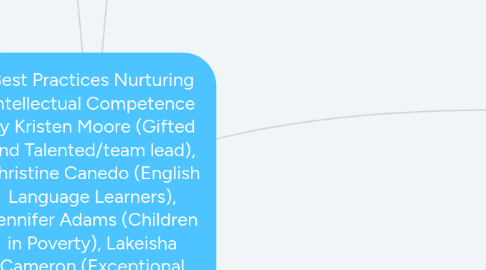
1. Gifted and talented learners
1.1. Best practices for developing the whole child: Offer the most difficult tasks first, speak to student interests, and allow students to collaborate. (Azzam, 2016)
1.1.1. Offer the most difficult tasks first, speak to student interests, and allow students to collaborate. (Azzam, 2016)
1.2. Diverse Learning Needs/Strategies for differentiating curriculum: local norms, subgroup norms for ELL students, push-in services, pull-out services, extension activities, small group instruction (Szymanski & Shaff, 2013); Plan for tiered learning, pre-assessments, extension of activities, and compacting the curriculum. (Azzam, 2016)
1.3. Incorporating multiple intelligences into curriculum planning: Provide many opportunities to explore significant concepts and topics on their own, to think about a topic in many ways, and to have different ways to make sense of what they find. (“Using Multiple Intelligence Theory to Identify Gifted Children,” 1997)
1.4. Social and developmental theories that would influence curricular decisions: Constructivism, Humanistic, Behaviorism, Cognitivism (Filipata, 2013)
2. English language learners
2.1. Best practices for developing the whole child
2.1.1. Provide good language models ELL students can copy and repeat.
2.1.1.1. Language learning requires a lot of repetition and practice. As language learners start to build their comprehension they begin to imitate sounds that they hear (TESOL, 2006)
2.1.1.2. Teacher AND Peer models
2.1.1.2.1. ELL students are not only interacting with teachers when they are in school. Allowing for ELL students to communicate with their peers will provide them with language models appropriate for English language suited for their age group.
2.1.2. Use of visual aids
2.1.2.1. Build oral skills
2.1.2.1.1. "Oral language is the foundation of literacy" (Louie & Sierschynski, 2015)
2.1.2.2. Picture books, videos, slideshows...etc.
2.1.2.2.1. Visuals give students an opportunity to interact with complex content. Using wordless materials, students have the opportunity to give their own ideas and make their own meanings (Louie & Sierschynski, 2015).
2.2. Diverse Learning Needs/Strategies for differentiating curriculum
2.2.1. The same general strategies are not going to work with every ELL student. Teachers have to take the time to look at their individual ELL students to find methods that will best benefit them.
2.2.1.1. It is important to remember that ELL students are NOT all the same. TESOL has five levels of English proficiency: 1) Starting 2) Emerging 3) Developing 4) Expanding 5) Bridging each with specifics about what ELLs in each level can do (2006).
2.3. Incorporating multiple intelligences into curriculum planning
2.3.1. All of the multiple intelligences can be used for ELL students. In particular, these will be especially helpful and easy to incorporate:
2.3.1.1. Kinesthetic
2.3.1.1.1. Learning through movement (Carreón-Sánchez, 2015). When language cannot be used as a means of communication, teachers can use movements to communicate and to introduce language.
2.3.1.2. Interpersonal
2.3.1.2.1. Pair and/or group projects
2.3.1.2.2. Student-centered, student-led activities
2.3.1.3. Visual
2.3.1.3.1. Using aids like graphs/diagrams, videos, slideshows, vocabulary cards
2.3.1.4. Naturalist
2.3.1.4.1. Hands-on lessons
2.4. Social and developmental theories that would influence curricular decisions
2.4.1. ELL students will learn the language as they learn the content.
2.4.1.1. Especially with the use of peer interactions. Allowing for ELL students to work with their peers gives them the opportunity to hear the peer language models.
3. Children from poverty
3.1. Best practices for developing the whole child-Set goals and hold them responsible for assignments.("5 Concrete Ways", 2019)
3.2. Diverse Learning Needs/Strategies for differentiating curriculum include but is not limited to creating new learning measures and breaking down curriculum.
3.3. Incorporating multiple intelligence's into curriculum planning such as adding music, pictures or physical experience can contribute to bettering the students outcome.("5 Concrete Ways", 2019)
3.4. Building relationships with students, breaking down assignments as well as breaking into small groups would influence curricular decisions.("5 Concrete Ways", 2019)
4. Exceptional learners
4.1. Best practices for developing the whole child include: Differentiated Instruction. Understanding behavioral assessments and Interventions. Rewarding a child's positive behavior. Providing a safe stimulating learning environment. Promote peer interactions.
4.2. Diverse Learning Needs/Strategies for differentiating Intellegences:
4.2.1. Incorporating diverse learning styles when teaching which will make the lessons more engaging to all the students in the class.
4.2.1.1. The VAK Learning Styles model Include: (ANON) Visual Learners: Respond to images and graphics. Auditory Learners: Prefer verbal presentations. Kinesthetic Learners: prefer a physical, hands on approach.
